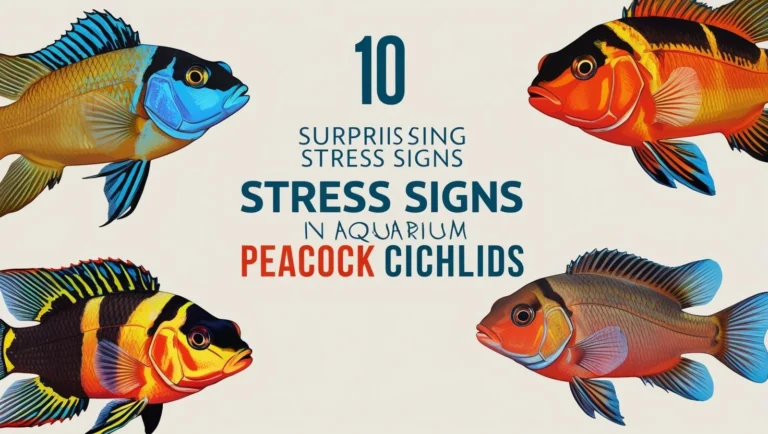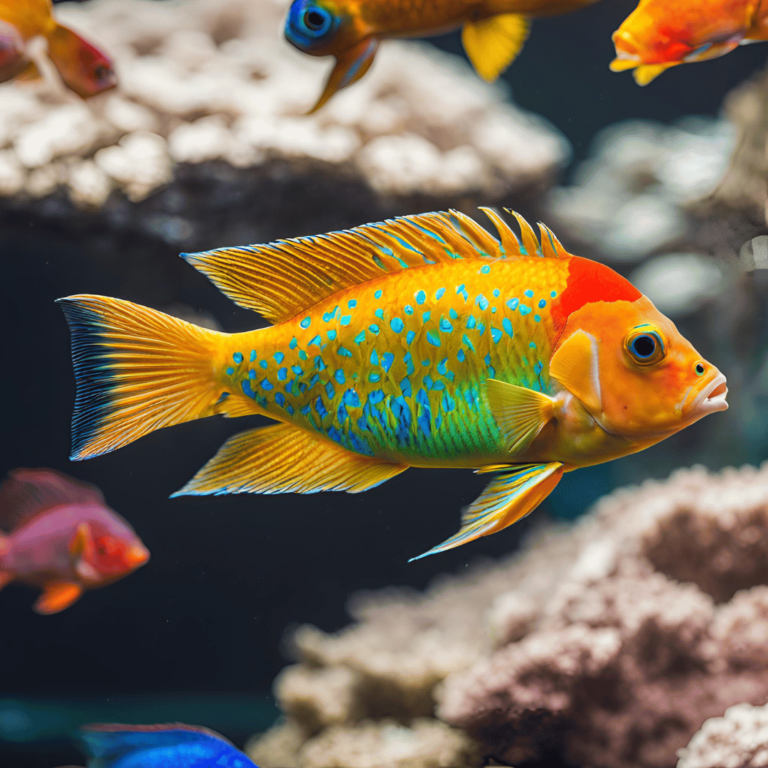Your trusted guide to cichlid care, tank setups, and quality products.

7 Best Tank Mates for Peacock Cichlids: A Guide to Harmony
Create a harmonious community in your peacock cichlid tank! Our comprehensive guide reveals the best compatible tank mates, considering size, temperament, and territorial requirements. Ensure a peaceful and thriving environment for your fish.
Image credit Canva
Creating a harmonious and thriving aquarium takes careful planning, especially when it comes to peacock cichlids. These colorful, semi-aggressive fish from Lake Malawi in Africa are known for their vibrant hues and unique personalities. However, their territorial nature means selecting the right companions is crucial for maintaining a peaceful aquatic community. Choosing the right tank mates for peacock cichlids ensures a balanced environment and prevents unnecessary stress.
In this comprehensive guide, we’ll delve into peacock cichlid behavior, characteristics of ideal tank mates for peacock cichlids, top companion options, and expert tips for crafting a stunning, balanced aquarium.
At PeacockCichlid.com, we believe in transparency and honesty with our readers. Some of the links in this article are affiliate links, which means we may earn a small commission if you make a purchase through them, at no additional cost to you. These commissions help support our site, allowing us to continue providing expert advice, in-depth guides, and valuable content for Peacock Cichlid enthusiasts like you.
We only recommend products that we trust and believe will be beneficial for your aquarium. Thank you for your support!
Understanding Peacock Cichlid Behavior and Their Tank Mates
Before adding other fish, it’s essential to understand peacock cichlids’ temperament and environmental needs:
- Temperament: Semi-aggressive, especially during breeding. Males can be territorial, while females are generally more peaceful.
- Tank Requirements: They thrive in large tanks with clear, hard, alkaline water.
- Activity Level: Peacock cichlids are active swimmers and need plenty of open space to explore while staking out territories in rocky or sandy areas.
By understanding their behavior, you can create an environment that promotes harmony and supports the interaction between peacock cichlids and their tank mates.
Water Parameters for Peacock Cichlids and Ideal Tank Mates
Maintaining the correct water conditions is key to ensuring the health of peacock cichlids and their tank mates:
- Temperature: 76–82°F
- pH Level: 7.8–8.6
- Hardness: 10–15 dGH
These parameters not only support peacock cichlids’ well-being but also ensure compatibility with their chosen tank mates for peacock cichlids.
What Makes a Good Tank Mate for Peacock Cichlids?
Selecting suitable companions involves understanding the following key factors:
- Compatible Water Conditions: All fish in the tank must thrive in hard, alkaline water.
- Size and Temperament: Avoid small or overly timid fish that may become prey. Opt for species with similar energy levels and semi-aggressive to peaceful temperaments.
- Activity Levels: Choose fish that complement rather than compete with the cichlids’ energetic swimming habits.
- Tank Role: Consider fish that occupy different parts of the tank (e.g., bottom dwellers, mid-level swimmers) to reduce territorial disputes and create a balanced ecosystem. This is particularly important when choosing tank mates for peacock cichlids.
Top 7 Tank Mates for Peacock Cichlids
Here are the best options for building a balanced aquarium:
1. Yellow Lab Cichlids (Labidochromis caeruleus)
Yellow labs are peaceful compared to most African cichlids and share similar water conditions. Their bright yellow color adds a stunning contrast to the tank’s visual appeal. Their docile nature makes them an excellent choice as tank mates for peacock cichlids.
2. Synodontis Catfish
Synodontis catfish are hardy bottom dwellers that mind their own business. By staying out of the cichlids’ way, they help reduce territorial disputes. Additionally, they act as natural cleaners by scavenging uneaten food and keeping the substrate tidy. Their adaptability makes them ideal tank mates for peacock cichlids.
3. Rainbowfish
Rainbowfish are fast swimmers with a calm demeanor. Their iridescent colors make them a beautiful addition, and their speed helps them avoid unwanted attention from territorial cichlids. They’re also known for their adaptability, thriving in a variety of water conditions, which makes them great tank mates for peacock cichlids.
4. Clown Loaches
Known for their playful nature, clown loaches are bottom dwellers that coexist peacefully with peacock cichlids. They also serve a functional purpose by controlling pests like snails. Keep them in small groups to ensure their happiness and activity, making them excellent tank mates for peacock cichlids.
5. Plecos (Suckermouth Catfish)
Plecos are the ultimate cleanup crew, managing algae growth and maintaining tank cleanliness. Their peaceful nature and preference for the tank’s bottom make them a perfect match for peacock cichlids. Be sure to provide hiding spots for their comfort. As quiet tank mates for peacock cichlids, they contribute to the tank’s harmony.
6. Larger Barbs (e.g., Tinfoil Barbs)
Tinfoil barbs are hardy and fast-moving, making them suitable companions. Their active swimming style matches the energy of peacock cichlids, and their robust size ensures they’re not seen as prey. They are dynamic tank mates for peacock cichlids.
7. Other Peacock Cichlids
A group of peacock cichlids can coexist peacefully with adequate space and the right male-to-female ratio. Aim for a 1:3 male-to-female ratio to minimize aggression and provide plenty of hiding spots to establish territories. Keeping the same species as tank mates for peacock cichlids can be a rewarding option if managed correctly.
Fish to Avoid in a Peacock Cichlid Tank
Certain fish are incompatible with peacock cichlids and should be avoided:
- Overly Aggressive Fish: Mbuna cichlids, red devils, and similar species can trigger constant fights.
- Small or Timid Fish: Guppies, neon tetras, and similar species may become prey.
- Fin-Nippers: Fish like tiger barbs and serpae tetras may damage the cichlids’ flowing fins, causing stress and injury.
Understanding which species to avoid is as important as choosing the right tank mates for peacock cichlids.
Tips for a Balanced Aquarium with Peacock Cichlids
Here’s how to create a thriving tank environment:
1. Tank Size Matters
A minimum of 55 gallons is recommended for peacock cichlids, with larger tanks needed for community setups. Adequate space prevents overcrowding and reduces aggression, ensuring harmony among tank inhabitants.
2. Aquascaping for Peace
Use rocks, caves, and plants to break up sightlines and provide hiding spots. These elements help reduce stress and territorial disputes among fish, creating a serene environment. This benefits both peacock cichlids and their tank mates.
3. Proper Feeding
Provide a balanced diet of high-quality cichlid pellets and occasional treats like brine shrimp or bloodworms. Ensure all fish receive appropriate food for their species to prevent competition. Balanced feeding supports peaceful interactions between peacock cichlids and their tank mates.
4. Regular Maintenance
Perform weekly water changes and monitor parameters to maintain optimal water quality. Cleanliness supports the health of all inhabitants and minimizes stress, benefiting peacock cichlids and their tank mates.
5. Monitor Behavior
Keep an eye on your fish for signs of stress, disease, or aggression. Adjust the tank environment or separate incompatible species as needed to maintain peace among peacock cichlids and their tank mates.
Conclusion
Creating a harmonious community with peacock cichlids is entirely possible with careful planning. By choosing compatible companions like yellow labs, Synodontis catfish, and rainbowfish, you can enjoy a visually stunning and dynamic aquarium. Avoid overly aggressive or timid species, and focus on maintaining optimal water conditions and ample space for all inhabitants. The right tank mates for peacock cichlids not only enhance the tank’s beauty but also foster a peaceful, thriving ecosystem.
A well-balanced tank not only showcases the beauty of peacock cichlids but also fosters a thriving ecosystem that you’ll enjoy for years to come. With the right choices and ongoing care, your aquarium will be a vibrant, peaceful underwater haven.
Enhance your peacock cichlid experience by exploring more of our expert resources on peacochcichlid.com. For instance, if you’re interested in maintaining a stress-free environment, our article 10 Signs of Peacock Cichlid Stress and How to Prevent It offers practical advice to keep your fish calm and healthy. You might also find Top 7 Common Peacock Cichlid Diseases and Prevention Tips useful for proactive health management, and our beginner-friendly guide, Peacock Cichlid Care: 7 Powerful Tips for Beginners, is perfect if you’re just starting out. Additionally, for tips on creating an ideal habitat, check out Peacock Cichlid Tank: 10 Expert Tips for a Stunning Setup.
We’re committed to helping you build a harmonious and thriving aquarium, so be sure to visit peacochcichlid.com again for more insights, and follow us on social media to stay updated with the latest tips and trends!
FAQ’s
What are the best tank mates for peacock cichlids?
Some of the best tank mates include yellow lab cichlids, Synodontis catfish, rainbowfish, clown loaches, and plecos. These species share compatible water parameters and temperaments.
Can peacock cichlids live with other cichlids?
Yes, peacock cichlids can live with other cichlids, such as yellow lab cichlids, as long as the tank is large enough to reduce territorial disputes and aggression.
Are small fish suitable tank mates for peacock cichlids?
Small fish like guppies or neon tetras are not suitable as they may become prey for the more aggressive peacock cichlids.
What should I avoid when choosing tank mates for peacock cichlids?
Avoid overly aggressive fish like mbuna cichlids or fin-nipping species like tiger barbs, as they can stress or injure peacock cichlids.
How many peacock cichlids can live together?
You can keep a group of peacock cichlids together, ideally with a 1:3 male-to-female ratio to minimize aggression. Ensure the tank is spacious with plenty of hiding spots.
Do plecos make good tank mates for peacock cichlids?
Yes, plecos are excellent tank mates for peacock cichlids due to their peaceful nature and role as tank cleaners.
Can peacock cichlids live with community fish?
Peacock cichlids can live with some community fish like larger barbs or rainbowfish, provided the tank environment suits all species.
Are there bottom dwellers suitable for a peacock cichlid tank?
Yes, Synodontis catfish and clown loaches are excellent bottom dwellers that coexist peacefully with peacock cichlids.
How can I reduce aggression in a tank with peacock cichlids and other cichlids?
Provide ample space, aquascaping with rocks and caves, and maintain proper male-to-female ratios to reduce aggression.
10. What water parameters are best for peacock cichlids and their tank mates?
Maintain a temperature of 76–82°F, a pH level of 7.8–8.6, and water hardness of 10–15 dGH for the best results.



